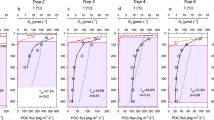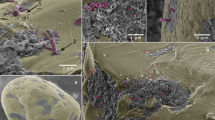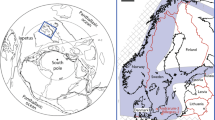Abstract
THE diffusive sublayer is the region of fluid next to a solid surface, where turbulence is suppressed and molecular diffusion dominates transport of solutes. Diffusive impedance of solute exchange across the benthic sublayer in the deep sea can limit the rates of some diagenetic reactions in the sediment. We present the first direct in situ measurements of the thickness of the diffusive sublayer for dissolved oxygen in the deep sea. The positions of 17 oxygen microelectrode profiles relative to the visible sediment/water inter-face reveal that the sublayer is 0.5–1.5 mm thick, with measurements ranging to 3.5 mm. The sublayer reduces the diffusive flux of oxygen into the sediments by ∼10% in these environments. Also, the diffusive flux of isotopically light carbon through the sublayer should cause the 13C content at the interface of typical deep-sea sediments to be ∼0.1%> lighter than the bottom-water value, setting a limit on the precision of the record of past bottom-water given by the carbon isotope composition of the shells of benthic foraminifera.
This is a preview of subscription content, access via your institution
Access options
Subscribe to this journal
Receive 51 print issues and online access
$199.00 per year
only $3.90 per issue
Buy this article
- Purchase on Springer Link
- Instant access to full article PDF
Prices may be subject to local taxes which are calculated during checkout
Similar content being viewed by others
References
Keir, R. S. Am. J. Sci. 282, 193–236 (1982).
Schink, D. R. & Guinasso, N. L. Jr in Fate of Fossil Fuel CO2 in the Ocean (eds Anderson, N. R. & Mlahof, A.) 375–400 (Plenum, New York, 1977).
Archer, D. E., Emerson, S. & Reimers, C. E. Geochim. cosmochim. Acta (in the press).
Boudreau, B. P. Am. J. Sci. 288, 777–797 (1988).
Jørgensen, B. B. & Revsbech, N. P. Limnol. Oceanogr. 30, 111–122 (1985).
Jahnke, R. A. & Christiansen, M. B. Deep Sea Res. 36, 625–638 (1989).
Berelson, W. M. et al. Mar. Tech. Soc. J. 21, 26–32 (1987).
Santschi, P. H., Bower, P., Nyffeler, U. P., Azevedo, A. & Broecker, W. S. Limnol. Oceanogr. 28, 899–912 (1983).
Boudreau, B. P. & Guinasso, N. L. Jr in The Dynamic Environment of the Ocean Floor (eds Fanning, K. A. & Manheim, F. T.) 115–145 (Lexington Books, Lexington, 1982).
Wimbush, M. & Munk, W. in The Sea Vol. 4 Pt. 1 (ed. Maxwell, A. E.) 731–758 (1970).
Balistrieri, L. S. & Murray, J. W. Geochim. cosmochim. Acta 50, 2235–2243 (1986).
Dawson, D. A. & Trass, O. Int. J. Heat Mass Transfer 15, 1317–1336 (1972).
Smith, K. L. Jr, Carlucci, A. F., Jahnke, R. A. & Craven, D. B. Deep Sea Res. 34, 185–211 (1987).
Smith, C. R., Jumars, P. A. & DeMaster, D. J. Nature 323, 251–253 (1986).
Carpenter, R. Deep Sea Res. 34, 881–896 (1987).
Krone, R. B. in Lecture Notes on Coastal and Estuarine Studies Vol. 14 (ed. Mehta, A. J.) 66–84 (Springer, Berlin, 1986).
Emerson, S. & Hedges, J. I. Paleoceanography 3, 621–634 (1988).
Tendall, O. S. & Hessler, R. R. Galathea Rep. 14, 165–194 (1977).
Lutze, G. F. & Thiel, H. in Berichte aus dem Sonderforschungsbereich (eds Altenbrach, A. V., Lutze, G. F. & Weinholz, P.) 313, 17–30 (Christian-Albrechts-Universität zu Kiel, 1987).
Shackleton, N. J. in Fate of Fossil Fuel CO2 in the Oceans (eds Anderson, N. R. & Malahof, A.) 401–428 (Plenum, New York, 1977).
Boyle, E. A. & Keigwin, L. D. Science 218, 784–787 (1982).
Helder, W. & Bakker, J. F. Limnol. Oceanogr. 30, 1106–1109 (1985).
Drake, D. E. in Suspended Solids in Water (ed. Gibbs, R. J.) 133–153 (Plenum, New York, 1974).
Emerson, S. E. in The Carbon Cycle and Atmospheric CO2: Natural Variations Archean to Present (eds Sundquist, E. & Broecker, W.) 78–86 (American Geophysical Union, Washington, D.C., 1985).
Andrews, D. & Bennett, A. Geochim. cosmochim. Acta 45, 2169–2175 (1981).
McCorkle, D. C., Emerson, S. R. & Quay, P. D. Earth planet Sci. Lett. 74, 13–26 (1985).
McCorkle, D. C. & Emerson, S. R. Geochim. cosmochim. Acta 52, 1169–1178 (1988).
Author information
Authors and Affiliations
Rights and permissions
About this article
Cite this article
Archer, D., Emerson, S. & Smith, C. Direct measurement of the diffusive sublayer at the deep sea floor using oxygen microelectrodes. Nature 340, 623–626 (1989). https://doi.org/10.1038/340623a0
Received:
Accepted:
Issue Date:
DOI: https://doi.org/10.1038/340623a0
This article is cited by
-
Variable diffusion boundary layer and diffusion flux at sediment-water interface in response to dynamic forcing over an intertidal mudflat
Chinese Science Bulletin (2012)
-
The burial efficiency of organic carbon in the sediments of Lake Kinneret
Aquatic Sciences (2011)
-
How do larvae attach to a solid in a laminar flow?
Marine Biology (2008)
-
Benthic microbial production of oxygen supersaturates the bottom water of a stratified hypersaline lake
Microbial Ecology (1995)
Comments
By submitting a comment you agree to abide by our Terms and Community Guidelines. If you find something abusive or that does not comply with our terms or guidelines please flag it as inappropriate.



